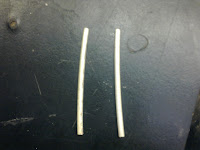The beginning stages of my woven building ring..
Wednesday, 28 November 2012
Saturday, 10 November 2012
manufacture process - chainmail ring -
Yes, it says chainmail. You might be asking yourself what happened to the weaving. As far as I'm concerned, chainmail is a variation of weaving and my thesis was on ''innovative INTERPRETATIONS of the weaving technique in contemporary jewellery design''.. Lets get started
I couldn't just make a chainmail ring that stands on its own because it would just flop all over the place so I decided to make a skeleton for the chainmail to be supported by. This required a 3mm thick bar of silver which I bent into an "n" shape and the other I made a huge jump ring which I soldered round.
I manufactured the skeleton by soldering the components together.
To make chainmail you need multiple jump rings. The materials I used were silver and copper.
After linking the jump rings together, the result starts to look like this (this is a very time consuming process.)
After I linked every jump ring to one another, the result was very impressive, and yes, I do say so myself.
The professionally photographed piece
manufacture process - woven gents ring -
This variation of weaving is different from the "1 spine" technique that I mentioned in my previous post. The difference is that I didn't use 1 spine. At the end of every horizontal section that I weave, I used the last wire as the spine so that means the spine is different each time (I hope you are still with me). Because the spine is different each time, this means the woven strand will slant to the left or to the right. Its a process that will make sense once you get stuck in.
I bent the woven strand to fit my middle finger.
I used 2 strands instead of 1 to form the shank because it looks more imposing as a piece of jewellery. I'm sure i'm not the only person who thinks so.
The top of the ring is essentially a box which I manufactured using 1mm thick plates. The box cover the ends of the woven shank as well as completes the ring, of course.
The finished ring
The professionally photographed piece
manufacture process -woven ladies ring-
I began with two, 3mm thick, round bars of metal, as shown in the 1st image. I bent the bars of metal into ''S'' shapes, as shown in the 2nd image.
I domed the ''S'' shaped bars so that the piece isn't flat.
I soldered the 2 domed, "S" shaped bars together.
The weaving technique I used was the basic, ''1 spine'' technique, which, as the name suggests, has 1 spine running through the whole strand. If you look carefully you can see the 1 spine that runs through the whole strand. The spine forms a continuous "s". The spine is the stability the keeps the structure together... I hope that all makes sense.
When the woven strand eventually got long enough I used my pliers to bend it around to take the shape of the domed "S" shaped bars. I proceeded to solder the woven strand to the "S" shape structure.
Monday, 5 November 2012
1 step forward, 3 steps back
I know its early days but I'm feeling like I wasted a day because I had some things in mind that I was exploring but it seems as though I was wasting my time. I'm thinking of looking into miniature buildings that are made using weaving techniques but all the info that i'm finding is very limited, I need to dig deeper
Friday, 2 November 2012
1st post
This post has nothing to do with anything I'm just posting this for the sake of posting just because I can
Subscribe to:
Posts (Atom)

























